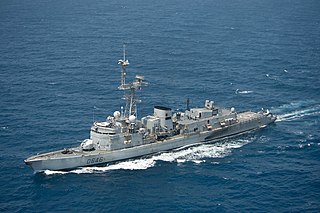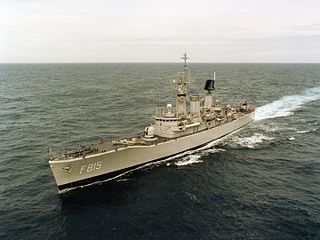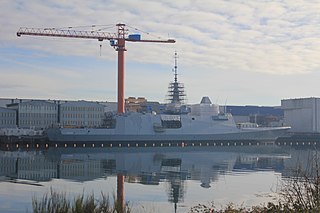
Surcouf (F711) is a La Fayette-class frigate of the French Navy. Construction began at Lorient Naval Dockyard on 6 July 1992, launched 3 July 1993, and the ship was commissioned May 1996. Since entering service, Surcouf has taken part in numerous missions, notably in Operation Antilope, Operation Trident (Kosovo) and Mission Khor Anga in the Djibouti zone.

The Type 23 frigate or Duke class is a class of frigates built for the United Kingdom's Royal Navy. The ships are named after British Dukes, thus leading to the class being commonly known as the Duke class. The first Type 23, HMS Norfolk, was commissioned in 1989, and the sixteenth, HMS St Albans was commissioned in June 2002. They form the core of the Royal Navy's destroyer and frigate fleet and serve alongside the Type 45 destroyers. They were designed for anti-submarine warfare, but have been used for a range of uses. Twelve Type 23 frigates remain in service with the Royal Navy, with three vessels having been sold to the Chilean Navy, and one being retired in 2021.

The 46 Knox-class frigates were the largest, last, and most numerous of the US Navy's second-generation anti-submarine warfare (ASW) escorts. Originally laid down as ocean escorts, they were all redesignated as frigates on 30 June 1975, in the 1975 ship reclassification plan and their hull designation changed from 'DE' to 'FF'. The Knox class was the Navy's last destroyer-type design with a steam turbine powerplant.

The La Fayette class is a class of general purpose frigates built by DCNS in the 1980s/90s and still operated by the French Navy today. Derivatives of the type are in service in the navies of Saudi Arabia, Singapore and Taiwan.

The Delhi-class destroyers are guided-missile destroyers of the Indian Navy. Three ships of this class are in active service. The Delhi-class vessels were the largest vessels to be built in India at the time of their commissioning. The ships were built by Mazagon Dock Limited (MDL) at a cost of ₹750 crore each.

The Georges Leygues class was a class of anti-submarine destroyers of the French Navy. They were multi-role ships due to their Exocet and Crotale missile armament, making them especially suitable for the defence of strategic positions, show of force operations, or as high seas escorts. The design was initially officially known as a "corvette" with the designation C70, but were internationally labelled an "anti-submarine destroyer". Subsequently, the French referred to the ships as "frigates" with the designation F70.

The Suffren class were two anti-air frigates of the French Navy, designed to protect a fleet against air threats, surface ships, and submarines. They were the first French ships to be built specifically as guided missile frigates. Ordered in 1960, the class was intended to be more numerous, but budget pressure from the French nuclear weapons program limited their number. The lead ship, Suffren, entered service in 1967 and the second ship, Duquesne, in 1970. They remained in service until the 2000s when they were replaced by ships of the Horizon class.

Latouche-Tréville was a F70 type anti-submarine destroyer of the French Navy (Marine Nationale).

Tourville is the lead ship of F67 type large high-sea frigates of the French Marine Nationale. The vessel is specialised in anti-submarine warfare, though it also has anti-air and anti-surface capabilities. She is named after the 17th century admiral Count Anne-Hilarion de Cotentin de Tourville.

De Grasse is a F67 type large high-sea frigate of the French Marine Nationale specialised in anti-submarine warfare, though she also has anti-air and anti-surface capabilities. She is named after the 18th century admiral count François Joseph Paul de Grasse.

Suffren was a Suffren-class frigate of the French Navy, designed to protect a fleet against air threats, surface ships, submarines, and, to a lesser extent, provide firepower against land objectives. She is the sister ship of Duquesne, and was decommissioned in 2001. She was the seventh French vessel named after the 18th century admiral Pierre André de Suffren.

Duquesne was a Suffren-class frigate of the French Navy. She was designed to protect a fleet against air threats, surface ships, submarines, and, to a lesser extent, provide firepower against land objectives. She is the sister ship of Suffren. She is the eighth French vessel named after the 17th century admiral Abraham Duquesne. Duquesne was decommissioned in 2008.

The FREMM, which stands for "European multi-purpose frigate", is a Franco-Italian family of multi-purpose frigates designed by Naval Group and Fincantieri. In France, this surface combatant is known as the "Aquitaine class", while in Italy it is known as the "Bergamini class". The lead ship of the class, Aquitaine, was commissioned in November 2012 by the French Navy. Italy has ordered six general purpose and four anti-submarine variants. France, on the other hand, has ordered six anti-submarine variants and two air-defense ones.

French Navy modernization is pursued on the basis of successive Projet de loi de programmation militaire. These defence modernization plans are formulated on a rolling basis pursuant to strategic, political and budgetary factors and pressures. The latest LPM covers the period 2024 to 2030 and is organized around four strategic priorities: strengthening deterrence, preparation for high intensity operations, protecting interests in all French territories and key domains and strengthening international partnerships.
The Force d'action navale is the 9,600-man and about 100-ship force of surface warships of the French Navy. As of 2018, it is commanded by Vice-Amiral d’Escadre Jean-Philippe Rolland.

The Rothesay class, or Type 12M frigates were a class of frigates serving with the Royal Navy, South African Navy and the Royal New Zealand Navy.

The Van Speijk-class frigates were built for the Royal Netherlands Navy in the 1960s. They were versions of the British Leander-class frigates with Dutch radars. The British design was chosen in order to enable rapid construction in order to replace elderly destroyer escorts and take up part of the NATO patrol duties of the decommissioned anti-submarine warfare carrier Karel Doorman. The ships were modernised in the late 1970s. All six ships were sold to the Indonesian Navy in 1986–1989 and five are still in service as the Ahmad Yani-class frigates.

The defence and intervention frigate or FDI, also known as the Frégate de Taille Intermédiaire or FTI, is a planned class of French frigates. As of February 2022, five ships have been ordered for the French Navy, with the lead ship being named Amiral Ronarc'h, and an additional three, more heavily armed vessels, for the Hellenic Navy, with the lead ship named Kimon.

Normandie (D651) is an Aquitaine-class frigate of the French Navy. The Aquitaine class were developed from the FREMM multipurpose frigate program.

Bretagne (D655) is an Aquitaine-class frigate of the French Navy. The Aquitaine class were developed from the FREMM multipurpose frigate program.




















